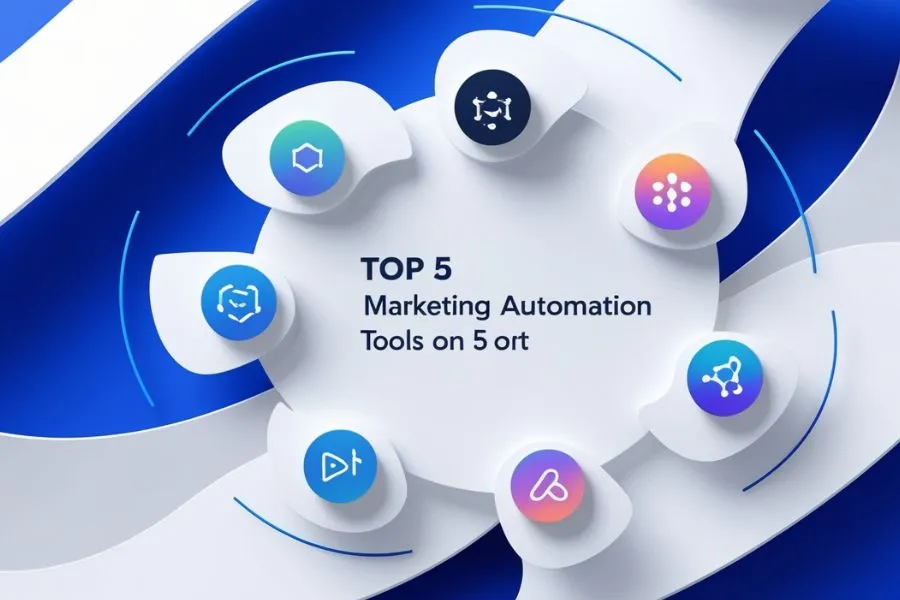Table of Contents
Introduction to Marketing Automation Tools
Marketing automation tools are like personal assistants for digital marketers, helping them to handle repetitive tasks, nurture leads, personalize campaigns, and analyze performance data. With the right tool, brands can focus more on crafting compelling messages rather than managing mundane tasks.
Top 5 Marketing Automation Tools

1. HubSpot Marketing Hub
HubSpot has become a household name in digital marketing for a reason. It’s an all-in-one platform that doesn’t just automate email but handles customer relationships, sales, and even content management.
Features of HubSpot
- Email Marketing: Automated email campaigns with segmentation.
- Lead Management: Tracks and nurtures leads through the sales funnel.
- Analytics: Powerful tools to analyze and optimize your marketing efforts.
- CRM Integration: Easily integrates with the HubSpot CRM for seamless workflows.
How to Use HubSpot for Automation
Getting started with HubSpot’s automation features is straightforward. Start by creating an email sequence, selecting the conditions for sending emails, and choosing the right audience segment. For lead scoring, HubSpot allows you to set specific criteria based on engagement metrics.
Example Scenarios for HubSpot
Imagine a scenario where a user downloads an ebook from your website. HubSpot can automatically send a thank-you email, followed by a series of nurturing emails, eventually leading the user to make a purchase.
2. ActiveCampaign
ActiveCampaign is designed for marketers looking to refine customer engagement with powerful automation and email capabilities. Known for its user-friendly design and flexibility, ActiveCampaign offers an affordable yet robust solution.
Key Features of ActiveCampaign
- Email Automation: Segment-based targeted emails.
- Sales CRM: Helps keep sales and marketing efforts in sync.
- Audience Segmentation: Allows precise targeting based on behavior.
- Advanced Analytics: Reports on campaign effectiveness.
How ActiveCampaign Works
Once you’ve imported your contacts, ActiveCampaign lets you set up automated workflows based on triggers like site visits, email opens, and more. You can even score leads and automate responses to improve engagement.
Practical Use Cases
ActiveCampaign is excellent for small to mid-sized businesses. For instance, an online store can use it to send product recommendations based on customers’ previous purchases, or a SaaS company can nurture leads after they attend a webinar.
3. Marketo by Adobe
Adobe Marketo has established itself as a top player for medium to large enterprises. While it’s pricier than some alternatives, it offers complex automation suited for B2B and B2C businesses alike.
Overview of Marketo Features
- Lead Management: Advanced segmentation and lead nurturing capabilities.
- Analytics: Multi-channel analysis of marketing effectiveness.
- Customer Journey Mapping: Visual maps to optimize engagement paths.
- Account-Based Marketing: Specialized tools for personalized B2B targeting.
How to Leverage Marketo for Marketing Automation
Marketo’s platform lets users build workflows through a drag-and-drop interface, allowing marketers to set up multi-step campaigns with specific triggers. It’s particularly powerful for nurturing relationships with long-term, high-value clients.
Real-World Example Applications
Consider a B2B company aiming to build long-term relationships with high-value clients. Marketo can be used to score these leads based on engagement and set up personalized outreach at strategic points in the sales cycle.
4. Pardot by Salesforce
Pardot is a robust B2B automation tool tailored for Salesforce users, providing valuable tools for nurturing leads, automating email marketing, and scoring prospects.
Essential Features of Pardot
- Lead Nurturing: Automated nurturing sequences tailored for B2B.
- ROI Reporting: Analyze which campaigns drive the highest ROI.
- CRM Integration: Good integration with CRM.
- Web Tracking: Tracks visitor activity on your website for tailored follow-ups.
Steps to Use Pardot Effectively
After connecting Pardot to Salesforce, you can start segmenting your audience, creating workflows, and defining lead scores. Pardot also allows you to track user engagement on your website to refine lead targeting.
Case Studies and Examples
Many B2B SaaS companies use Pardot to handle complex customer journeys. For example, Pardot can send customized emails when a lead reaches a specific score, signaling the sales team to follow up.
5. Mailchimp
Mailchimp is an ideal tool for small businesses looking to automate their marketing on a budget. With its intuitive interface and various templates, it has earned its spot as a go-to solution.
Core Features of Mailchimp
- Email Marketing: Drag-and-drop email builder with templates.
- Audience Segmentation: Basic and custom segmentation options.
- Social Media Management: Publish directly to social media.
- Reports and Analytics: Provides insights on email performance.
Setting Up Automation with Mailchimp
Using Mailchimp is as simple as selecting your automation goal—such as welcoming new subscribers, abandoned cart follow-ups, or win-back campaigns. Mailchimp’s templates make it easy to set up these workflows in minutes.
Common Use Scenarios
Mailchimp is great for eCommerce businesses wanting to nurture subscribers. For example, it’s commonly used for cart abandonment emails that encourage potential customers to complete their purchase.
Comparison of Marketing Automation Tools
| Tool | Best For | Key Features | Price Range |
| HubSpot | All-in-One Solution | CRM integration, lead nurturing, analytics | Moderate |
| ActiveCampaign | SMBs | Segmentation, CRM, email automation | Affordable |
| Marketo | Enterprises | Advanced analytics, ABM, customer journey mapping | High |
| Pardot | B2B, Salesforce | Lead scoring, Salesforce integration | High |
| Mailchimp | Small Businesses | Easy automation, social integration | Budget |
Key Factors to Consider Before Choosing a Marketing Automation Tool

- Cost: Determine if the tool fits within your budget.
- Features: Ensure it has the necessary features for your goals.
- Ease of Use: Some tools are complex, so look for user-friendly options if you’re new to automation.
- Integration: Verify if the tool integrates with your current CRM or other software.
- Support: Good customer support can save time during setup and troubleshooting.
Conclusion
Marketing automation tools are revolutionizing the way businesses reach their audiences. From the budget-friendly Mailchimp to the robust Marketo, each tool has unique advantages for different needs and budgets. By automating your marketing efforts, you can focus more on what truly matters—building relationships with your customers.
FAQs
1. What is the best marketing automation tool for small businesses?
Mailchimp is often recommended for small businesses due to its affordability and ease of use.
2. Can I use multiple marketing automation tools together?
Yes, you can, especially if each tool specializes in a unique function, but it’s essential to avoid overlap.
3. Does HubSpot integrate with other CRMs?
Yes, while it works best with HubSpot CRM, it can also integrate with others, like Salesforce.
4. What industries benefit the most from Pardot?
Pardot is ideal for B2B industries, particularly those in tech and professional services.
5. How long does it take to set up marketing automation?
Setting up can range from a few days to several weeks, depending on the tool and the complexity of the workflows.

